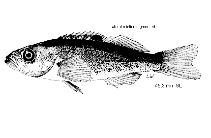| Distinguished from S. flavidus by: high pectoral fin ray count (usually 19); fewer lateral line pores (usually <50); deeper, shorter caudal peduncle; pelagic juveniles have spot on first dorsal fin.
Pigmentation:
Preflexion: initially, dorsally on gut, about 16 in series on ventral margin of tail (from about postanal myomere 4-6 through 18), and 1 or 2 ventral to notochord in caudal region; by 4.3 mm, gut covered, 1 or more on midbrain, nape, and lower jaw, some coalescence in series on ventral margin of tail (about 9 in series, closer together posteriorly), 1 on dorsum opposite posterior end of ventral tail series, heavy on inner surface of pectoral fin base and on pectoral fin blade; by 5.7 mm, about 8 on dorsum opposite posterior part of ventral tail series.
Flexion: more on brain and nape; patches in otic and opercular regions and on trunk above pectoral fin base; heavy on pectoral and pelvic fins; ventral tail series embedded; line on dorsum from middle of dorsal fin base to caudal peduncle; 1 or more on lateral midline at caudal peduncle-hypural region.
Postflexion: by 11.0 mm, on snout, upper jaw, postorbital region, more on top of head and on opercle, on dorsum from nape to caudal fin, on ventral margin of caudal peduncle, posteriorly on anal fin base, and on posterior hypural margin; by 16.0 mm, more extensive on dorsal half of head, lateral midline streak extends from hypural region to trunk, increasing on epaxial region of trunk; by end of stage, head covered except lower cheek and ventral regions, heavy on dorsum, body covered above lateral midline (accentuated at myosepta), pale ventrally on body, and series on anal fin base.
Pelagic juvenile: head covered, except on cheek; body covered, except on chest and ventral trunk region; heavy on dorsum; first dorsal fin covered with spot at 8th-12th spines; proximally on second dorsal fin.
Sequence of fin development: caudal, pectorals, dorsal and anal and pelvics.
Also Ref. 34817. |
